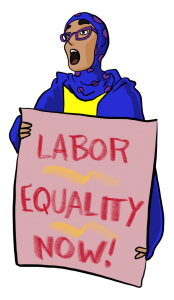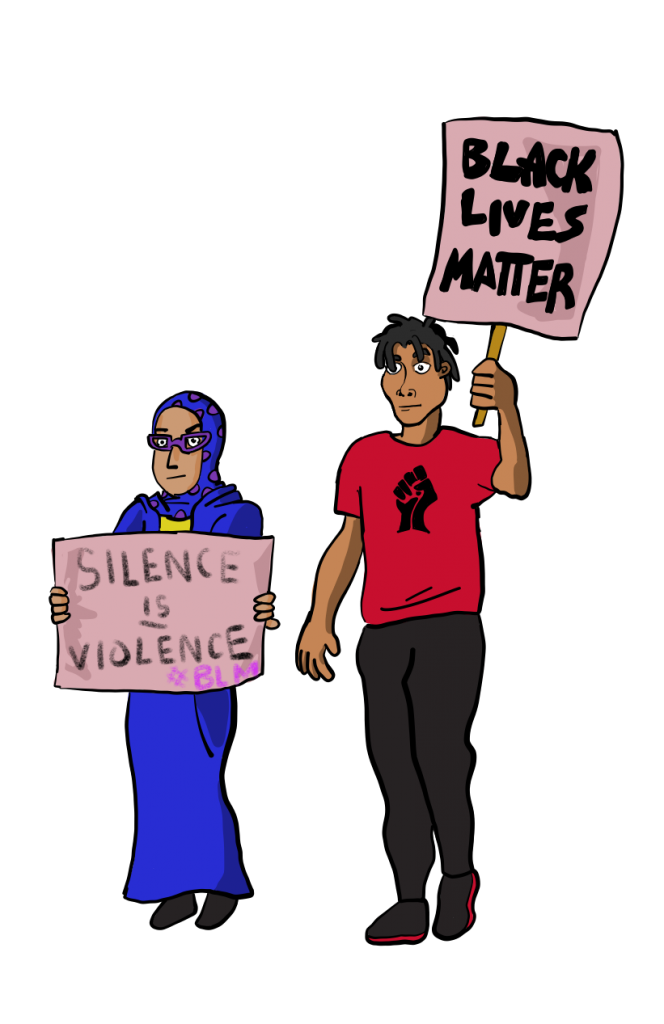Young people, from children to young adults, have brought critical leadership to civic movements.


In 1899 the New York City children known as “newsies,” who delivered newspapers for low wages went on strike. One of their strike leaders, Louis “Kid Blink” Baletti, was 18 years old; and some of the boys were as young as eight. Fred Hampton was a teenager when he began organizing with the NAACP and 20 when he became Deputy Chairman of the Chicago Black Panther Party. Elaine Brown was 26 when she helped that same organization establish the first free breakfast program for children. General Baker was in his 20’s when he co-found the Dodge Revolutionary Union Movement in Detroit. Alicia Garza was 32 when she started the Black Lives Matter hashtag launching a movement and eventually an organization.
Last but not least, high school students have changed public education time and time again. From Wayne State Latinx students organizing to establish the Center for Chicano-Boricua Studies (now the Center for Latino/a and Latin American Studies); to Detroit’s Northern High School walk out when Black students had similar demands about curriculum and the poor quality of education.
There is a place, and a critical one, for young people to lead in social and political change in Detroit. Check out these stories of younger people taking action over time.
Petition and Picket for Green Graduate Gowns


In 1963, a student at Northeastern High School named Lamar N. Richardson Jr. organized a petition to change the graduation gown from black to green. A change like this may seem insignificant to organize around however at the root of it was frustration with being treated unequally. Northeastern was primarily African-American at that time with a white administration and Lamar’s experience there was characterized by receiving second hand equipment such as band instruments marked with Denby High School’s name. “Denby got new stuff, we got their old stuff,” he said.
Despite Northeastern’s school colors being gold and green they were required to wear black graduation robes unlike Cass Technical High School and The High School of Commerce. Lamar was also told by the principal that green robes would “contrast too much” with the brown skin of the school’s Black students. So, Lamar led the senior class in collecting letters from their parents supporting the new graduation robe color for Northeastern High School and they followed up with a picket. Later that year, the students organized again, protesting the school’s new American History books. The books devoted only two pages to African American history. This work, occurring just ahead of the Civil Rights Movement is not well documented and it’s unclear whether or not Lamar and his classmates accomplished their goals, but the high school students organized around the issues they cared about and set an example for other students in the community.
Detroit Woman Doesn’t Make it Home from Selma
The marches from Selma, Alabama to Montgomery, Alabama for Black people to register to vote was a peaceful demonstration met with an incredible amount of violence. Over the course of three days demonstrators marched and were attacked and beaten by police and white supremacists. Viola Liuzzo, a Wayne State student and member of NAACP who had first participated in campus demonstrations, then rode with the Southern Christian Leadership Conference to participate in the three days of demonstration marching and supporting first aid. It was at their conclusion, while providing transportation to protestors between Montgomery and Selma, that she was murdered by Klansman on Highway 80.
Liuzzo is the only known white woman to be killed during the Civil Rights Movement and for her life sacrifice she’s received a number of posthumus awards including a Detroit park being named for her at 20087 Winthrop St on the west side.
The Viola Liuzzo Papers can be found at Detroit’s Walter Reuther Library.
The Right to an Education


In 1966, Northern High School students staged a walkout protesting the low quality and unrepresentative education they believed they were receiving as well as the racist actions of the school’s administration. Black students were being discouraged from higher education by counselors and encouraged toward city service work. The principal used racist language to refer to students and when an editorial in the student paper by Chuck Colding outlined the what they found to be unacceptable learning conditions–including overcrowded classrooms, inadequate facilities, poor educational opportunities, aggressive on-campus police and discriminatory behavior by counselors and some teachers–was censored followed by Chuck’s removal from the paper, the students had had enough. Of the 2,307 students enrolled in the school, only 183 didn’t participate in the demonstration rallying around a demand for the removal of Principal Arthur Carty. Their demonstration was successful and all of their demands were met.


Northern High School became an all girls school–Detroit International Academy for Young women in 2005–in part because of a community of high school girls, including Muslim girls like me, who wanted an all girls community to connect with one another and learn about one another’s culture.
One policy that came out of the civil rights era in an attempt to address racial inequities was affirmative action. Originally an executive order by both Presidents John F. Kennedy and Lyndon B. Johnson, affirmative action started as a federal government mandate that employers not discriminate in hiring. As the standard evolved, universities began adopting affirmative action policies that gave weight to racial minorities on their applications. Under these policies, for example, if a white student and a Black student with comparable qualifications (e.g. gpa’s, test scores, etc.) applied for admission, the Black student’s application would receive a weight based on the racial minority identity giving that student a more competitive edge within the application pool. These policies were an effort to increase diversity on university campuses and account for the disparate educational opportunities racial minorities have had access to compared with white Americans. In 2003, the Supreme Court Case Grutter v. Bollinger, affirmed the University of Michigan’s use of race in application review, however in another case decided the same day Gratz v. Bollinger, the Supreme court struck down the weighting, or point system, used when evaluating the race of applicants. Leading up to this decision, college students from the University of Michigan’s student organization Students Organizing for Labor and Economic Equality (SOLE) organized and demonstrated in support of affirmative action at the university. Jackie Bray was a sophomore at the University of Michigan in 2002 and organized a bus trip to D.C. with hundreds of students from campus and community members from across Southeast Michigan to demonstrate outside the Supreme Court.
College students have also been essential to shaping the curriculum of their schools by demanding to be represented within the courses of study. The Wayne State Center for Chicano-Boricua Studies is one of the oldest Latinx Studies programs in the midwest, but it almost didn’t exist. In 1971, Osvaldo “Ozzie” Rivera, a Puerto Rican Detroiterer, and about 35 other students were a part of a leadership program established by local community organizations LA SED, New Detroit, Inc., and Wayne State. The Latino en Marcha Leadership Training Program was only intended to last one year however, Ozzie and his peers organized to not only keep the program but establish a program of study on Latinx history and issues and a center for community outreach and Latinx student services.
The African-American Students of Wayne State
In 1989, Black students at Wayne State organized around the subject of curriculum as well. Protesters held an 11-day “study-in” advocating for the creation of an Africana Studies program. Over 100 students came together as a temporary study group, The African-American Students of Wayne State and conducted their “study-in” in the former Student Center Building demanding not only that the program be supported by the university but also made into an accredited liberal arts program.
Education is an issue heavily dictated by public policy, so it’s no surprise the number of education related court cases. In 2016, Detroit students took on the Constitution in court arguing that the publicly funded education system, and the school district while under state control, had not adequately prepared them in math or literacy. Their litigation lasted for four years going through the different levels of the court facing rejections and appeals before finally, in 2020 the 3rd Circuit Court of Appeals ruled that the state had, in fact, been negligent and denied students access to literacy. The students started their battle as teenagers, 16 years old, and finished it at the age of 20. The case, Gary B. v. Whitmer, led to a settlement with the 2020 Governor’s office that directs additional funding to the now Detroit Public Schools Community District and will set precedent and have lasting implications for other court cases surrounding public education in the years to come.
Affirming The Right To Read


Anti-War Protests
When causes are worth fighting for, and in some cases, risking your life for, an energy can rise up amongst the people. Following the 1967 Rebellion in Detroit, unrest still simmered and the Vietnam War (which at this point had been fought for 12 years) was a major concern for young people, many of whom were young men of draft-age and expected to serve in the war.
Detroit high school students were some of many young people in the Anti-Vietnam War activities, and they reached far and wide to make their voices heard. One school boycott on April 3rd, 1969 united high schools in both Detroit–Cass, Cooley, Denby, Mackenzie, Mumford, Murray-Wright, Northern, Northwestern–and the suburban communities of Ferndale, Oak Park, River Rouge, Southfield, Royal Oak. That protest even included 3 middle schools, McMichael, Webber, and Wilson and students also asked that teachers take part in their activities.
Another protest in October of 1967 took part in National days of action and united high school students in opposition to the Selective Service System, or nationwide draft of soldiers. All men between the ages of 18 and 26 were eligible for the draft, and if chosen were required to fight in the Vietnam war. Young men were given draft cards with a number on it to know if they had been drafted. 17 youth in Detroit returned their draft cards to the Selective Service Office at the downtown Cadillac Tower building, directly showing their disagreement over being forced into war. In a statement the protestors said:
“Because of the draft, a few men at the head of the government have complete power to commit American men to die anywhere in the world. This power must be curbed. These men do not represent us and have stated they will follow their own policies, regardless of the will of the people.”
The Narrative of the 1967 Riot Rebellion


29-year-old Herb Boyd saw they were trying to blame the riot on one person’s arrest and he wasn’t going to have it. “I was living in Fullerton and 12th street, right in the belly of the beast and right near where much of the stuff went down. That’s where Michael Lewis was arrested. They were going to blame him for the whole ‘67 riot. I got into a letter-writing campaign. That was the first time I was so moved to do something like that. When they grabbed Michael to be the scapegoat for the 1967 riot I said, ‘No, I ain’t hearing that.’ For the first time I saw my name in print, connected to political action. I got moved by that.”
Herb Boyd would continue to ensure the narrative of Black people in Detroit wasn’t lost or overlooked and go on to write the book Black Detroit: A People’s History of Self-Determination.
Youth Voice in Detroit’s Government
It might seem like older citizens have control of everything, but Detroit’s city charter and Michigan’s Constitution actually guarantees young people a seat at the table. For most local offices like the School Board or Mayor, you only need to be 18, a registered voter and a Detroit resident (for a defined period of time) to run for election. Additionally, the Detroit City Charter’s Community Advisory Councils have a designated seat for young Detroiters. Establishing the Community Advisory Councils (CAC) is a complicated process and hasn’t been historically successful but the option is there. There can be one CAC for each city council district. To establish one, first the council district must run a petition with signatures of at least 10% of voters in the last municipal general election. Once established, the CAC must be connected with their council district for direct communication with their councilperson must attend every meeting. The youth role on the CAC’s is designated for a 13 -17 year old “high school member” and once the CAC is established, the city council must determine a process for selecting that person.
Marcena W. Taylor, first African-American Firefighter in Detroit


Marcena W. Taylor was one of two African American firefighters to integrate the Detroit Fire Department in the late 1930s. While working at the post office, Taylor was told about a possible position with the Detroit Fire Department. Of the 5,000 people who sat for the exam, only about 60 were African American. Taylor was hired into the fire department in 1939 where he and Arnold White became the first two Black firefighters in the city. He was 28 years old. Taylor held that position in the face of discrimination within the department including threats from his white colleagues and segregated lunch periods when he would be forced to eat after the rest of the team. Despite that, he also became the first African American officer when he was appointed Sergeant in 1952 and the first African American Battalion Chief in 1969. Chief Taylor retired from the Detroit Fire Department in 1971.
“Youth” is relative.


To the 90 year old woman, the 60 year old is young. However, there is a point in life when we are all considered young based upon our education level, our ability to work, and our overall independence from adults. Being young does not define our ability to create change in our communities, our government, or our society. It is not age that determines successful policy and government practices. Younger citizens have proved throughout history the importance of their voices and how essential youth political and civic engagement is to a city like Detroit.
Within the 21st century, young people in Detroit have organized and been elected. 2007 Detroit Public School students supported teacher strikes protesting school conditions and wages and 2018 youth activism was growing even more. In 2018 alone, Cass Tech students organized the March for Our Lives protest for federal gun regulations, BYP 100’s Detroit Chapter (a group of 18-35 year old Black and LGBT Detroiters) launched their Greenlight Black Futures campaign against city surveillance, and Black Lives Matter Detroit organized for the release of Siwatu-Salama Ra (a local activist unjustly jailed for legal use of her firearm). Young people lead in elected politics as well. Kwame Kilpatrick was the youngest elected mayor at age 31. At 27 Misha Stallworth was the youngest ever elected Detroit School Board member, at 26 Detroit Councilwoman Mary Sheffield was the youngest ever elected council person, and at 19 Jewell Jones was the youngest ever elected Inkster councilperson.
Young people are sometimes told they have to wait their turn or that they don’t have enough experience to lead the work that creates civic change. Experience helps, but what’s equally important is being informed, committed to the good of the community as opposed to personal status, determined, and passionate. In short, effective leadership is rarely ever defined–or limited–by age.
Lesson Review
Now that you’ve had discussion and explored your ideas, write a short essay responding to the same question: Do you think young people have a voice in changing policy? Why or why not? Explore whom you are referring to when you think about “young people.” For example, what ages are you thinking of and how does that connect to your ideas about creating change?
